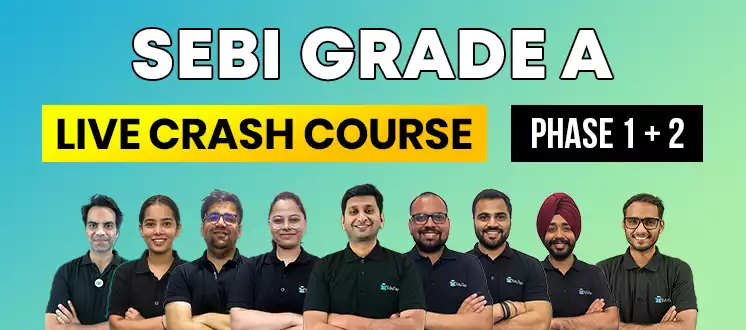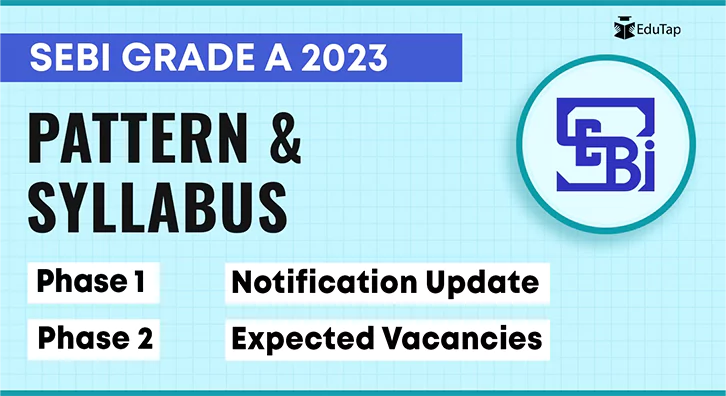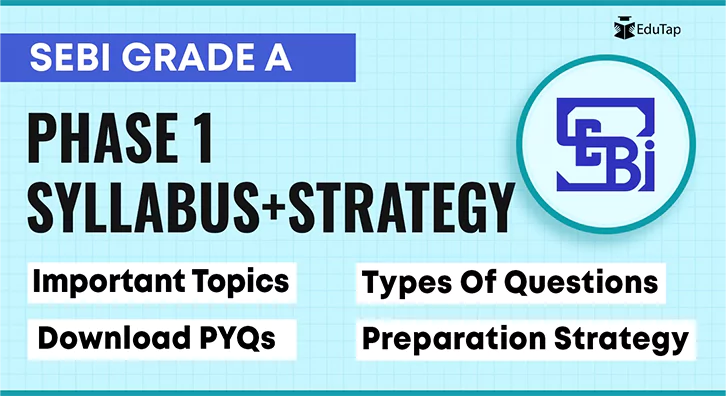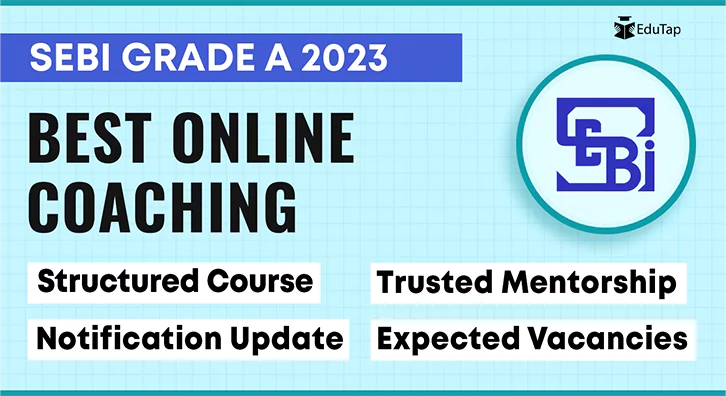The job profile of a SEBI Grade A officer depends on the department in which you are posted. Here are the major departments in SEBI and their work in brief:
Corporate Finance Department (Mergers and Takeovers)
This department oversees the regulatory and supervisory aspects of mergers, acquisitions, and takeovers in the financial markets.
Department of Economic and Policy Analysis (Research Work)
This department is responsible for conducting in-depth research and analysis for the formulation of policies and regulations.
Department of Debt and Hybrid Securities
It supervises and regulates the debt and hybrid (debt-equity mix) segments of the capital markets.
Enforcement Department (Enforcement, Prosecution, Penalty)
This department ensures the enforcement of regulatory guidelines and takes action against those in violation, including prosecution and imposition of penalties.
Recovery and Fund Department
In cases where SEBI imposes fines on individuals or organisations, and they fail to pay, this department is responsible for recovering the fines.
General Services Department (Accounts, Security, Facility Management)
This department manages internal accounts and ensures the security of SEBI premises. It also oversees the maintenance and functionality of facilities, including air conditioning and cafeteria services.
IT Department
The IT department is responsible for managing IT-related services, including the SEBI website, computer systems, servers, and other technology infrastructure.
The Legal Affairs Department provides legal counsel to SEBI and its various units. It assists with legislative drafting, policy matters related to securities laws, and legal opinions. This department supervises and regulates various market intermediaries such as brokers, merchant bankers, investment banks, and custodians. It plays a crucial role in ensuring transparency, integrity, and ethical conduct within the organisation. Its primary functions and responsibilities include preventing corruption, investigations, taking disciplinary actions, etc. Legal Affairs Department
Market Intermediaries Regulation and Supervision Department
Vigilance Department
The eligibility criteria outlines essential information such as academic qualifications and age restrictions that applicants must meet to be considered for the SEBI Grade A exam.
Eligibility: Age
For the SEBI Grade A exam, there is no minimum age requirement. However, the maximum age is 30 for the General Category based on the cut-off date as per the notification year.
Age Relaxations
SEBI provides age relaxations for various categories as listed below:
- 5 years for SC/ST
- 3 years for OBC
- 10 years for Person with Benchmark Disability [PwBD (UR)]
- 13 years for PwBD (OBC)
- 15 years for PwBD (SC/ST)
- 5 years for Ex-servicemen (served at least 5 years of continuous military service)
Eligibility: Educational Qualification
Applicants need a Master’s Degree in any discipline, (OR) a Bachelor’s Degree in Law, (OR) a Bachelor’s Degree in Engineering from a recognized university.
Additionally, candidates who have cleared all levels of CA / CFA / CS / CWA are also eligible.
The SEBI Grade A exam is a 3-phase selection process. Each phase is designed to assess the different skills and knowledge required for the role.
- Phase 1 (Pre)
- Phase 2 (Mains)
- Phase 3 (Interview)
SEBI Grade A Phase 1 Exam Pattern
The SEBI Grade A Phase 1 exam is an objective-type test that evaluates the candidate’s fundamental knowledge and understanding of various subjects. It is qualifying in nature and serves as a screening test to shortlist candidates for the next rounds of the examination. Phase 1 consists of 2 papers.
Phase 1 Paper 1
SEBI Grade A Phase 1 Paper 1 comprises 80 multiple-choice questions with a total of 100 marks and is to be completed within a 60-minute time frame. These questions are spread across four subjects (20 questions per subject), which include:
- General Awareness (Incorporating questions of easy to moderate difficulty level, particularly pertaining to the Financial Sector)
- English Language
- Quantitative Aptitude
- Test of Reasoning
For your easy understanding, we have provided the above-mentioned information in a table form below.
| SEBI Grade A Paper 1 (Phase 1) | |||
| SNo. | Section | No of Questions | Max Marks |
| 1 | General Awareness | 20 | 25 |
| 2 | English Language | 20 | 25 |
| 3 | Quantitative Aptitude | 20 | 25 |
| 4 | Reasoning | 20 | 25 |
Phase 1 Paper 2
The SEBI Grade A Phase 1 Paper 2 for the general stream comprises 100 marks and 40 minutes are given to complete the paper. It includes 50 multiple-choice questions (2 marks each) covering a range of subjects, such as:
- Commerce
- Accountancy
- Management
- Finance
- Costing
- Companies Act
- Economics
For your easy understanding, we have provided the above-mentioned information in a table form below. One-fourth of the marks are deducted for each wrong answer, which applies to both Paper 1 and Paper 2 in the SEBI Grade A Phase 1 exam. No marks are deducted if a candidate leaves a question blank on the OMR sheet. SEBI Grade A Phase 1 exam is designed as a qualifying round, where the marks obtained are exclusively used for shortlisting candidates for Phase 2. These Phase 1 marks do not contribute to the final selection of candidates. Since SEBI Grade A Phase 1 is of a qualifying nature, fixed cut-offs are set for both Paper 1 and Paper 2. The cut-off for Paper 1 is a minimum of 30% i.e. 30 marks out of 100, while for Paper 2, it is a minimum of 40% i.e. 40 marks out of 100.. Candidates need to secure separate cut-offs in each paper as mentioned above as well as aggregate cut-off marks of 40% i.e. 80 marks out of 200 in the Phase 1 exam to be shortlisted for Phase 2. For the SEBI Grade A phase 1 exam, no separate merit list is prepared according to the number of vacancies advertised and calling ratio. All you have to do is score atleast 30 marks in Paper 1, 40 marks in Paper 2, and a total of 80 or more marks in Paper 1+2 to be shortlisted for the Phase 2 exam. Question papers for both Paper 1 and Paper 2 are available in both Hindi and English, except for the English language test. This bilingual approach ensures that candidates are comfortable with the language in which they are most proficient, promoting equal opportunity for all. For your easy understanding, we have provided the detailed SEBI Grade A Phase 1 exam pattern information in a table form below. SEBI Grade A Phase 2 is the second stage of the selection process. Candidates shortlisted for Phase 2 receive new hall tickets specifically for this stage. For candidates who have applied in multiple streams, Paper 2 is conducted in various shifts, the timings of which are intimated in the hall ticket. Similar to the Phase 1 exam, the Phase 2 exam also consists of 2 papers. SEBI Grade A Phase 2 Paper 1 comprises descriptive English questions with a total of 100 marks and is to be completed within a 60-minute time frame. It comprises three topics i.e., essay, precis, and reading comprehension. For your easy understanding, we have provided the above-mentioned information in a table form below. SEBI Grade A Phase 2 Paper 2 for the general stream comprises 100 marks and 40 minutes are given to complete the paper. It includes 50 multiple-choice questions (2 marks each) covering a range of subjects, such as One-fourth of the marks are deducted for each wrong answer, which applies to both Paper 1 and Paper 2 in the SEBI Grade A Phase 2 exam. No marks are deducted if a candidate leaves a question blank on the OMR sheet. SEBI Grade A Phase 2 exam has specific minimum cut-off criteria. Candidates must score a minimum of 30% in Paper 1 i.e.30 marks out of 100 and a minimum of 40% i.e. 40 marks out of 100 in Paper 2. Furthermore, candidates need to secure aggregate cut-off marks of 50% i.e. 100 marks out of 200 in the Phase 2 exam to be shortlisted for Phase 3. The aggregate marks are calculated with the weightage of 1/3rd for Paper 1 and 2/3rd for Paper 2. For e.g., if a candidate has appeared for both Paper 1 and Paper 2 of the SEBI Grade A Phase 2 exam and scored 90 and 60 marks, respectively. To calculate the aggregate marks: For Paper 1, you take 1/3rd of the marks, which is (1/3) * 90 = 30 marks. For Paper 2, you take 2/3rd of the marks, which is (2/3) * 60 = 40 marks. Now, add these weighted marks to get aggregate marks: 1/3rd marks of Paper 1 + 2/3rd marks of Paper 2, i.e. 70 marks out of 100. This is how the aggregate marks are calculated by assigning different weightages to Paper 1 and Paper 2, with Paper 2 carrying more weight in the final score. Question papers for both Paper 1 and Paper 2 are available in both Hindi and English, except for the English language test. For your easy understanding, we have provided the detailed SEBI Grade A Phase 2 exam pattern information in a table form below. Important Note: Candidates who meet the specified criteria are shortlisted for Phase 3, which is the Interview round. Typically, the number of candidates shortlisted for Phase 3 is approximately three times the number of available vacancies. These candidates are shortlisted in order of merit. The SEBI Grade A interview is the final stage of the selection process for candidates who have successfully cleared the Phase 1 and 2 examinations. Here is the SEBI Grade A Phase 3 pattern: The final selection is based on the aggregate marks obtained in Phase 2 (Papers 1 and 2) and the interview. To calculate the final aggregate marks, let’s take the same example of a student who has scored 70 marks out of 100 in SEBI Grade A Phase 2 Paper 2. Now, apply the Paper 2 Phase 2 weightage of 85% to this score, which is 85% of 70 equals 59.5 marks. In addition to Paper 2 Phase 2, let’s assume the student scores 6 marks during the interview, bringing the total to 59.5 + 6 = 65.5 marks. So, the final aggregate marks for the students are 65.5.
SEBI Grade A Paper 2 (Phase 1)
SNo.
Section
No of Questions
Max Marks
1
Commerce
50 questions covering these 7 sections
2
Accountancy
3
Management
4
Finance
5
Costing
6
Companies Act
7
Economics
Total
50
100
Negative Marking
Phase 1 Nature
Cut-Off
Paper Language
SEBI Grade A Phase 1 Exam Pattern
SNo.
Paper
Stream/Subjects
Maximum Marks
Duration
Cut Off
1
Paper 1
All Streams: Multiple choice questions on the subjects viz. General Awareness (including some questions related to the Financial Sector of easy to moderate difficulty level), English Language, Quantitative Aptitude, and Test of Reasoning.
100
60 Minutes
30%
2
Paper 2
General Stream: Multiple choice questions on subjects Commerce, Accountancy, Management, Finance, Costing, Companies Act & Economics.
100
40 Minutes
40%
Legal, Information Technology & Official Language stream: Multiple choice questions on Specialized subjects related to the stream.
100
40 Minutes
40%
Research Stream: Multiple choice questions on subjects Economics, Econometrics, Statistics, Finance and Commerce.
Aggregate Cut-Off
40%
SEBI Grade A Phase 2 Exam Pattern
Phase 2 Paper 1
SEBI Grade A Paper 1 (Phase 2)
SNo.
Section
Topic
No of Questions
Max Marks
1
Descriptive English
Essay
You need to attempt 1 out of 4 questions
100
Precis
1
Reading Comprehension
4-5
Phase 2 Paper 2
SEBI Grade A Paper 2 (Phase 2)
SNo.
Section
No of Questions
Max Marks
1
Commerce
50 questions covering these 7 sections
2
Accountancy
3
Management
4
Finance
5
Costing
6
Companies Act
7
Economics
Total
50
100
Negative Marking
Cut-off
Paper Language
SEBI Grade A Phase 2 Pattern
SNo.
Paper
Stream/Subjects
Maximum Marks
Duration
Cut Off
Weightage
1
Paper 1
All Streams: English (Descriptive Test) to test the drafting skills
100
60 Minutes
30%
1/3rd
2
Paper 2
General Stream: Multiple choice questions on subjects Commerce, Accountancy, Management, Finance, Costing, Companies Act and economics.
100
40 Minutes
40%
2/3rd
Legal, Information Technology & Official Language stream: Multiple choice questions on Specialized subjects related to the stream.
100
40 Minutes
40%
2/3rd
Research Stream: Multiple choice questions on subjects Economics, Econometrics, Statistics, Finance and Commerce.
Information Technology Stream: Coding Test (Languages: C++/ JAVA/Python)
100
180 Minutes
40%
2/3rd
Aggregate Cut-Off
–
–
50%
–
SEBI Grade A Phase 3 (Interview) Pattern
Understanding the SEBI Grade A exam syllabus significantly impacts the preparation strategy and success in the examination. Below is the detailed syllabus of SEBI Grade A Phases 1 and 2.
SEBI Grade A Phase 1 Syllabus
Here’s an overview of the syllabus for Phase 1 of the SEBI Grade A Examination.
Paper 1
Below, we have explained the Paper 1 syllabus of the SEBI Grade A Phase 1 exam:
-
General Awareness (GA)
GA is divided into 2 parts, static and current affairs. As per our analysis of previous year question papers, 2-3 questions are asked from the static part and 17-18 questions are from the current affairs part of GA. The following topics are most frequently asked from the general awareness section:
Current GA Syllabus
- National News: MoUs, summits and major events related to India.
- International: Summits and conferences held abroad.
- Financial & Economics News
- Financial Awareness: RBI and SEBI Notification and Regulations
- Defence: Military exercises, drills and major updates related to the defence sector of India
- Days in News: Major events or days, along with its date and theme
- Persons in News: Obituaries, appointments, retirements
- Sports: Major tournaments and its winners
- Science, Technology and Space
- Awards and honours
- Environment
- Banking, Economy related news
- Reports and Government Schemes
- Books and Authors
Here is the English Language syllabus for the SEBI Grade A Phase 1 exam: Here is the Quantitative Aptitude syllabus for the SEBI Grade A Phase 1: Here is the Reasoning Ability syllabus for the SEBI Grade A Phase 1: Below, we have explained the Paper 2 syllabus of the SEBI Grade A Phase 1 exam: Here is the Commerce and Accountancy syllabus for SEBI Grade A Phase 1: Important Note: There are some Commerce and Accountancy topics that are not explicitly mentioned in the SEBI Grade A syllabus but are important from the exam point of view. These topics are: Here is the Management syllabus for the SEBI Grade A Phase 1: Here is the Finance syllabus for the SEBI Grade A Phase 1: Here is the Costing syllabus for the SEBI Grade A Phase 1: Here is the Companies Act syllabus for the SEBI Grade A Phase 1: Important Note: There are some Companies Act topics that are not explicitly mentioned in the SEBI Grade A syllabus but are important from the exam point of view. These topics are: Here is the Economics syllabus for the SEBI Grade A Phase 1: Here’s an overview of the syllabus for Phase 2 of the SEBI Grade A examination: Below, we have explained the Paper 1 syllabus of the SEBI Grade A Phase 1 exam: The English paper is designed to evaluate writing skills, assessing the ability to express ideas and comprehend topics effectively. It includes precis writing, essay writing, and reading comprehension. The essay topics encompass diverse areas such as Economy/Finance, Technology/Internet, Abstract concepts, and Social Issues. Additionally, precis passages are derived from prominent newspapers, and reading comprehension questions are based on provided paragraphs. Below, we have explained the Paper 2 syllabus of the SEBI Grade A Phase 2 exam: The syllabus of Paper 2 is the same for both Phase 1 and Phase 2. However, it is important to know that the difficulty level of Paper 2 is higher in Phase 2. Static GA Syllabus
English Language
Quantitative Aptitude
Reasoning Ability
Paper 2
Commerce and Accountancy
Management
Finance
Costing
Companies Act
Economics
SEBI Grade A Phase 2 Syllabus
Paper 1
English
Paper 2
SEBI Grade A 2022 Phase 2 Cut-off
| Stream | SC | ST | OBC
(NCL) |
EWS | UR | PwBD
(ID& MD) |
PwBD
(VI) |
PwBD
(HI) |
PwBD
(LD) |
| General | 55.67 | 53.00 | 58.00 | 59.33 | 62.34 | 56.00* | 55.00 | 52.33* | 57.00 |
SEBI Grade A 2020 Phase 2 Cut-off
| Stream | SC | ST | OBC
(NCL) |
EWS | UR | PwBD
(AU) |
PwBD
(VI) |
PwBD
(HI) |
| General | 57.66 | 51.67 | 60.00 | 57.17 | 66.00 | 49.00* | 57.17 | 47.83* |
Develop a preparation strategy for the SEBI Grade A phase 1 exam by following the steps below. They will help you effectively target the syllabus as a beginner.
SEBI Grade A Phase 1: Preparation Strategy
Step 1: Lay a Strong Foundation
- Begin by thoroughly understanding the SEBI Grade A Phase 1 Paper 1 syllabus.
- Delve into previous year’s questions (PYQs) from the past two years (2020 and 2022) to gain insights into exam pattern and asked topics.
Step 2: Grasp the Exam Structure
- Familiarise yourself with the SEBI Grade A exam pattern.
- Remember that Phase 1 is a qualifying exam only.
Step 3: Draft a Strategic Approach
- Develop an effective study plan to cover the entire syllabus.
- Utilize a variety of study resources, including mock tests and available courses, to effectively tackle Quantitative Aptitude and Reasoning.
- Enhance your English language proficiency by expanding your vocabulary and strengthening your grammar skills.
- Prioritize the latest three months of Current Affairs, supplementing your preparation with compilations rather than newspaper reading.
- Prioritize the subjects of Management, Company Law, and Finance due to their Factual foundation and relative ease of preparation.
- Gradually transition to Costing, Economics, Commerce, and Accounts.
Step 4: Develop Specific Skills
- Integrate numerical questions into your study routine to balance factual concepts with practical applications.
- Remember, application is key. Focus on understanding and applying concepts rather than cramming the syllabus.
SEBI Grade A Phase 2: Preparation Strategy
When developing an effective preparation strategy for Phase 2 of the SEBI Grade A exam, the most important question is where to start. Here are a few points you need to remember when developing your preparation strategy for the SEBI Grade A Phase 2 exam.
- Even though the Paper 2 syllabus is the same, the types of questions asked in Phase 2 are different from Phase 1.
- Phase 2 will have numerical questions from subjects like Commerce, Accountancy, and Costing.
- The SEBI Grade A exam questions are application-based, requiring you to apply concepts learned in subjects like Economics and Accounts.
- For subjects like Companies Act and Management, focus on consistently revising the factual information.
Now that you are clear with the base of your strategy, let’s look at the two key focus areas that will help you score high marks in Phase 2.
SEBI Grade A phase 2 preparation is essential for achieving a high score and securing a place in the SEBI Grade A interview process. How to prepare for SEBI Grade A phase 2 effectively involves utilising the best sources, such as high-quality study materials, practice questions, and mock tests.Descriptive English
Numerical Questions
Free Resouces
SELECT YOUR ONLINE MENTORSHIP COURSE
Strengthen your exam preparation with true MENTORSHIP and choose the course as per your learning needs.
OUR SUPER MENTORS
Meet our extraordinary teachers who are synonymous with expertise in their subjects. They are highly acclaimed for adding immense value to students’ preparation. Our students owe their success to them!

- B.Tech, MBA
- Content Head at EduTap
- Guided Aspiring Learners

- B.A (Maths), M.Sc (Statistics)
- Exceptional Teaching Skills
- The Ultimate ‘Quant Guru’

- B.Sc in PCM
- Promotes Conceptual Understanding
- Introduces Different Approaches

- M.A English
- The Ultimate English Mentor
- Our ‘Shashi Tharoor’

- Bachelor of Commerce
- Simplifies Current Affairs
- Guided Aspiring Learners

- B.Tech (Mechanical)
- Former RBI Grade B aspirant
- Guided Aspiring Learners

- BMS (Finance)
- DBF (JAIIB) Certified
- Guided Aspiring Learners

- LLB, MA (Economics)
- Company Secretary

- M.Com, JRF (Commerce)
- Ex- Accountant, GOI
- Makes Accounting a Cakewalk
STUDENT TESTIMONIALS
Listen to our students share their learning experiences as part of the EduTap family!




FREE RESOURCES LIBRARY
Dive deep into our free knowledge library and access Video Lectures, Previous Year Questions, Mock Tests, E-Books, Current Affairs, and more.
Memory-based year-wise compiled previous year question papers of all exams.
Weekly current affairs compilations important covering newspapers and websites.
Online lectures by our expert faculty to build a strong foundation of subjects.
Downloadable PDFs covering important topics in a crisp and easy to digest format.
Chapter-wise, sectional and full-length tests to assess your actual preparation level.
Recommended articles
Stay up-to-date with the latest articles written after thorough research of SEBI Grade A exam and excel in your exam preparation.
Frequently Asked Questions (FAQs)
Start by understanding the syllabus thoroughly and creating a study plan accordingly. Cover each topic comprehensively, refer to standard textbooks, practise previous year question papers, and attempt mock tests. Stay updated with current affairs and economic developments.
Yes, there is an age limit, and it varies depending on the stream you apply for. For general posts, a candidate must not have exceeded the age of 30 years (as of the notification date). However, it is crucial to check the specific age criteria in the official SEBI Grade A notification.
The difficulty level of the SEBI Grade A exam varies from year to year. However, based on the analysis of previous year’s question papers, the majority of questions fall under the easy to moderate category.
No. The syllabus for Paper 2 of both phases is the same. Hence, the same resources are applicable.
EduTap provides free access to solved PYQs for both Phase 1 and Phase 2 of the SEBI Grade A exam. The links in this article are categorised by year for both phases, making it easy to find the PYQs you need.
A dedicated study plan of 4-6 months is recommended to thoroughly cover the SEBI Grade A Phase 2 syllabus and adequately prepare for the exam. This time frame allows you to grasp key concepts, practice problem-solving, and refine your exam-taking strategies.
Yes, each section of the exam requires tailored preparation strategies. For instance, the descriptive English paper demands strong vocabulary, grammar, and comprehension skills, while Paper 2 focuses on subject-specific expertise, numerical question-solving abilities, and conceptual application of the syllabus.
EXPLORE OTHER EXAMS
Discover more about other related exams of the Regulatory Bodies Segment.

IFSCA Grade A officer dives deep into the regulatory landscape of financial services, encompassing banking, insurance, securities markets, and more.

Work as an Assistant Manager with Securities and Exchange Board of India
Work as an Assistant Manager with National Bank for Agriculture and Rural Development



















